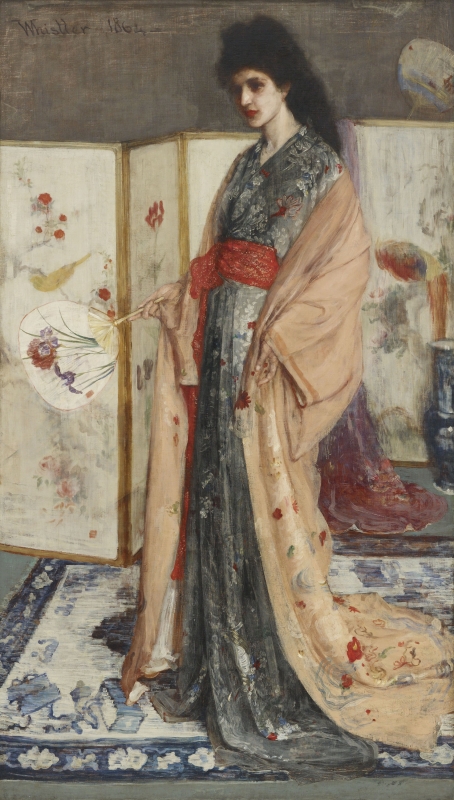Composition
Sketch for 'La Princesse du pays de la porcelaine' [YMSM 049], shows the same pose but not the same model.
A later pastel by Whistler, Japanese lady decorating a fan [M.0460], appears to have been inspired by this composition. It is signed with a butterfly that dates from 1870/1872. The pose of the model echoes that in the painting, but the model (who is not Christine Spartali) faces right instead of left. The chair in the background is further to the right and the pot and draperies of the painting are omitted. The pastel relates to a later project for a decoration for the South Kensington Museums.
Technique
The canvas is a fairly fine weave.
The sitter's sister, Marie Spartali (Mrs W. J. Stillman) (1844-1927), told the Pennells:
'The first day, when they arrived in the studio, Whistler had his scheme prepared. The Japanese robe was ready, the rug and screen were in place, and he gave the pose at once. There are a number of small studies and sketches in oil and pastel that show how he had perfected the idea beforehand. They used to come to him twice a week, and this continued through the winter of 1863-64. At first the work went quickly, but soon it began to drag. Whistler often scraped down the figure just as they thought it all but finished, and day after day they returned to find that everything was to be done over again. Their parents got tired of it in the end, but not the two girls, who shared Whistler's enthusiasm. Mrs. Stillman remembers that Whistler partly closed the shutters so as to shut out the direct light ; that her sister stood at one end of the room, the canvas beside her; that Whistler would look at the picture from a distance, then suddenly dash at it, give one stroke, then dash away again. She remembers too that, as a rule, they arrived about half past ten or a quarter to eleven, that he painted steadily, forgetting everything else, that it was often long after two before they lunched. ...The sittings went on until the sitter fell ill. Whistler was pitiless with his models. The head in the Princesse gave him most trouble. He kept Miss Spartali standing while he worked on it, never letting her rest ; she must keep the entire pose, and she would not admit her fatigue as long as she could help it. During her illness, a model stood for the gown, and when she was getting better, he came one day and made a pencil drawing of her head, though where it went to Mrs. Stillman never knew. There were a few more sittings after this, and at last the picture was finished.' 1
Aileen Tsui describes the variations in treatment seen in different areas of the canvas:
'Amid its effusion of colorful patterns, the painting represents the figure of Christina Spartali dressed in a kimono, her pale face and black hair set against the oddly vaporous gray paint in the upper section of the image ... In contrast to the mistiness of the gray paint in this upper band, the rest of the painting below presents to the viewer a variety of decorative surfaces rendered as flatly brushed patches, spots, dashes, and streaks of pigment. … Corporeal insubstantiality, spatial expansiveness, and color untrammeled by modeling or representational demands work together to produce painting as an overall surface of colored areas that register the painter's touch. Whistler's attention to decorative surfaces in La Princesse – such as rendering the pattern on the silvery kimono with as much precision and vividness as the features on the model's pale face – may be seen to present East Asian objects in their visual intensity as rivaling the expressiveness of the human figure.' 2
Conservation History
Freer Gallery of Art files record that it was cleaned and repaired in 1922, relined in 1931, resurfaced in 1942, had all three treatments in 1950, and was cleaned, retouched, and revarnished in 1970.
Frame
1864: An 1864 Whistler frame, with carved decoration: raised flat outer edge with carved cross-hatch/ lacquer box pattern; inner frieze of carved whorls and Japanese mon roundels, stylized chrysanthemums at the corners and stylized tripods at the midpoints; raised inner edge of carved Greek keys and bevelled site edge. English made, possibly by Joseph Green in 1864. 3
It is one of the finest and most intricately made of Whistler’s frames, with carved decoration rather than the composition ornament typically seen on late 19th Century frames.
It is believed to have remained on the painting since 1864. When Whistler decorated Harmony in Blue and Gold: The Peacock Room [YMSM 178] between 1876 and 1878, the framed picture was itself framed by decorative shelving, specially designed to enclose it.
In 1892 the painting was removed from Harmony in Blue and Gold: The Peacock Room [YMSM 178] and sold at auction; in 1903 it was bought by Charles Lang Freer (1856-1919) . In the following year he purchased The Peacock Room, which was re-erected, first in Detroit and then in Washington DC, and the framed painting was restored to its gilded setting.
Last updated: 22nd December 2020 by Margaret












